Trip Info
-
Minivan, 4x4 Modified Safari Vehicle
-
3* to 5* Hotels, Lodges, Guesthouses
-
Dinner, Bed and Breakfast
-
English, German, French, Spanish
-
Scheduled Guided Tour
-
Easy to Moderate
-
Min: 4 & Max: 8
-
All year round
-
Windhoek City
-
Windhoek City
-
12
-
75
Overview
This trip unlocks the greatest highlights of Namibia. Meet up-close with Big Cats at Okonjima, the Africat Foundation and Etosha National Park – home to 114 mammal species, 340 bird species, 110 reptile species, 16 amphibian species and, surprisingly, one species of fish before immersing yourself in our culture; meeting Himba people in Epupa Falls Area and then proceed to see Twyfelfontein’s rock engravings.
Proceed to Swakopmund – Namibia’s premier holiday resort (West Coast Recreational Area). Continue to the Namib Desert where you spend 2 nights at Sesriem and Sossusvlei. Stroll among the world’s highest sand dunes in the world’s oldest desert. This trip departs from Windhoek every Thursday morning.
Trip Highlights
- Meet up-close with Big Cats at Okonjima, the Africat Foundation.
- Etosha National Park - home to 114 mammal species, 340 bird species and 110 reptile species.
- Immerse yourself in our culture; meeting Himba people in Epupa Falls Area of Kaokoland.
- Explore the World Heritage Site of Twyfelfontein’s rock engravings.
- Enjoy relaxation and optional activities in Swakopmund - Namibia's premier holiday resort.
- Sossusvlei, stroll among the world’s highest sand dunes in the world’s oldest desert.
Itinerary
This morning, a Tour Guide from Nali Safaris will collect you from your various accommodation establishments or from the Windhoek International Airport (assuming you land before 08h00). You then depart Windhoek in your safari vehicle with your private guide and head north via Okahandja town for a short visit to a local market, to shop for woodcarvings and curios. The local community operates the stalls on a co-operative basis and the market is a perfect place to do last minute shopping for truly Namibian souvenirs.
We then proceed to Okonjima Africat Foundation, the highlight at this sanctuary is the tracking of cheetah and leopard safaris. Okonjima Africat Foundation is situated halfway between the capital Windhoek and the Etosha National Park, the 55,000 acre Okonjima Game Reserve has some of the best accommodation in Namibia. We arrive in good time to join excursion at the foundation.
You will be taken on a tour during which you will be able to meet, close-up-and-personal, some of the cheetah that are going through the Africat rehabilitation programme. Most of the animals currently living at Okonjima have been rescued from various desperate situations, being orphaned or caught in a trap, and the aim of the rehabilitation process is to attempt to re-introduce them into the wild.
Overnight: Okonjima Plains Camp or similar
You join an early morning excursion for leopard tracking in the Jeep, after the excursion you will return to the lodge for a brunch meal. After the brunch meal we exit Okonjima Africat Foundation on our way to Etosha National Park. You will spend 2 nights in this world-class game park in your touring vehicle, visiting a number of waterholes to observe the wildlife. Etosha translated, means ‘The place of dry water’ and here we get our first view of the magnificent salt pan. Etosha National Park is home to 114 different mammal species including zebra, springbok, eland, oryx, kudu, giraffe and the all-important big four: the lion, the leopard, the elephant and black and white rhino. The wide variety of animals guarantee impressive game viewing. Etosha is also a bird watchers’ paradise, with more than 340 bird species recorded in the park.
**Memorable Moment: The Etosha Pan is a vast, bare, open expanse of shimmering green and white that covers around 4 800km², almost a quarter of the beautiful Etosha National Park. At 130 km’s long and up to 50km’s wide in places, it is comfortably the largest salt pan in Africa and is the park’s most distinctive and dramatic feature, visible even from space.**
You then make a lunch stop at Halali Wildlife Resort located in the middle of the park. After lunch you proceed with game viewing on your way to overnight accommodation, Okaukuejo Wildlife Resort. The rest of the remainder of the afternoon is at your leisure (from experience, this is usually welcomed after an exhilarating full day game viewing seated in the vehicle).
After sunset floodlights illuminate the waterhole. This is the best time and place to see the endangered black rhino. This archaic mammal can often be seen drinking alongside lion and elephant. The number and interaction of the animals is the major drawcard of Okaukuejo Rest Camp in Namibia.
Overnight: Okaukuejo Wildlife Resort or similar
Famous for its floodlit waterhole Okaukuejo Rest Camp is also the administrative centre of Etosha. Most visitors travel though this camp with its characteristic stone tower and Etosha Ecological Institute is also situated within the camp. The rest camp was formerly a military outpost founded in 1901 and the tower was added in 1963. Located in the south of Etosha National Park, Okaukuejo is only 17 km from Anderson Gate.
Okaukuejo offers a wide range of accommodation as well as all the necessities such as a petrol station and a shop. The restaurant and bar offer refreshments and delicious meals, while the swimming pool offers relief on hot days. The waterhole is a hub of animal activity starting in the early hours of the morning. Especially during winter diversity of game congregate in close proximity to the camp to quench their thirst.
This morning you will need to rise early for a magical wildlife encounter’s experience with your guide in the famous Etosha National Park, normally setting off before sunrise with luck on your side, you will observe nocturnal animals in the early mornings. We spend another day in Etosha’s unique desert landscape searching out for amongst other animals it’s large population of elephants and marvelling at its prolific bird life.
Unlike other parks in Africa, where you can spend days looking for animals, Etosha’s charm lies in its ability to bring the animals to you. Just park your car next to one of the many water holes, then wait and watch while a host of animals – lions, elephants, springboks, gemsboks etc. – come not two by two but by the hundreds.
Etosha’ s essence is the vast Etosha Pan, an immense, flat, saline desert that, for a few days each year, is converted by rain into a shallow lagoon teeming with flamingos and pelicans. In contrast, late in the dry season, everything, from the elephants to the once-golden grasslands, seems cast, spectrelike, in Etosha’s white chalky dust. And what wildlife there is! Even if you’ve had a taste of African wildlife watching previously, you are likely to be mesmerized by it here.
Overnight: Dolomite Tented Camp or similar
Dolomite Camp has 20 luxuriously appointed safari style tents. The tents face east or west creating magical views of the sunrise or sunset. Large comfortable beds, massage showers, an en-suite bathroom and private pools in some of the tents will make you feel right at home in Namibia.
After an early morning breakfast we exit the park in the western side of Etosha via Galton Gate on our way to Kaokoland in Epupa Falls area. One of the highlights of Kaokoland in the far northern reaches of Namibia, Epupa is a magical belt of makalani palm forest on the perennial Kunene River.
There’s something special about this Kaokoland refuge 180km north of Opuwo, where the Kunene River plunges into the gorge below. Baobab trees cling to the rocky slopes as torrents of water rumble and tumble down the rocks with a flash of rainbow and an invigorating burst of wonder.
In between rest and relaxation, there is much to experience here. Take the golden opportunity to visit the Himba, one of the last semi-nomadic groups in Africa; get your courage in check for a guided walk in search of the Kunene crocs or a rafting trip on the river (seasonal); and follow trails downstream keeping eyes open for our avian friends who favour this riverine habitat. And at sunset join the sundowner drive to a hill overlooking Epupa Falls for that time of day when everything pauses for beauty and celebration. Drink in the African ambience and magic of Epupa.
Overnight: Omarunga Epupa-Falls Camp or similar
Two hundred metres upstream from the cascading falls, Omarunga Epupa-Falls Camp is a cosy thatched lodge on the riverbank set under the palms, and the perfect place from which to experience Epupa enchantment. Dine with a river view and wake to the music of the falls and the sound of palm thrushes singing in the trees. Let Epupa lull you into a peaceful reverie.
We rise early this morning for a day which is sure to prove most memorable. With their intricate hairstyles and traditional adornments, the Himba are one of Namibia’s most distinctive tribes. We spend time with these proud people, learning about their captivating heritage and special way of life.
Book and join any activity offered by the lodge (at clients own cost):
Visit to a Himba Village, rate @ N$ 945.00 pp
A close up guided experience of the traditional lives of the Himba in the Epupa area. Duration 3-4.
You will have time to ask questions; interact and photograph one of the last remaining nomadic tribes of Africa, while our guide answers and explains the Himbas intricate traditions, customs and beliefs. Guests are welcome to buy souvenirs / bracelets and any items on display from the traditional Himba market during the visit.
There a lot of smiles exchanged and appreciation shown by humble negotiation of the beautiful crafts on display. After the excursion, a food gift will be presented to the Himba as a token note of appreciation and for the warm welcome. Morning departure is at: 8h00 after breakfast. Afternoon departure is at: 14h30 after lunch. Duration is approximately 2 – 3hrs long to have the guests back at the lodge in time for lunch or dinner depending on their activity time slot.
Sunset Walk, rate @ N$ 410.00 pp
Enjoy a guided walk to a beautiful scenic sundowner hill above the Epupa Falls where snacks and drinks.
Walking Trail, rate @ N$ 385.00 pp
A scenic and beautiful 2 hour guided walk upstream along the Kunene River. You might also see the vervet monkeys. This is also a great walk for bird enthusiasts.
Rafting Tours and Excursions, rates on request at the lodge
Fun and excitement! Explore the Kunene River by rafting boat, this activity is seasonal.
Overnight: Omarunga Epupa-Falls Camp or similar
After an early morning breakfast we depart to the northern part of Damaraland in the area of Palmwag. Palmwag concession – protected area for rare game species. The immense area is an extremely important refuge for rare animal species, some of which are threatened with extinction. It is estimated that more than 70% of the hooked-lipped rhinos that are still living in the wild can be found here.
The fascinating desert-dwelling elephants, mountain zebras and giraffes also roam the area. A healthy population of antelopes attracts a substantial number of large predators such as leopards, cheetahs and spotted hyenas. In addition, a group of “desert lions” has adapted to the arid conditions of the Palmwag concession.
Between Kaokoland and the Skeleton Coast, where the flat-topped Etendeka Mountains and the carpet of rich red rock greet the tributaries of the Uniab River, lies Palmwag Lodge and Camp. Amid swaying makalani palms and robust mopane trees nourished by underground water, the lodge overlooks the sweeping northern Damaraland landscape peppered with green euphorbias.
Feel the freedom of the north-western corner of Namibia, one of Africa’s last wildernesses, a refuge for black rhino and lion, and home to the famous desert elephant that follow the ephemeral rivers spanning the land like arteries of life. The hustle and bustle of daily living dissipates here as you entertain a slower rhythm of life. In the Kaokoveld extremes, where wildlife wanders freely, the infinite dome of blue sky holds sway during the day, and at night, the brilliance of the night sky takes the stage.
Join a guided hike, a day or morning of exploration or a sundowner drive in the 582 000-hectare Palmwag Concession, a vast conservation area with an abundance of wildlife. Palmwag collaborates with neighboring conservancies, the Ministry of Environment and Tourism and Save the Rhino Trust to safeguard this rich wild heritage, offering guests extraordinary unrivalled African experiences.
Overnight: Palmwag Lodge or similar
After breakfast and morning excursions are done, we depart to southern Damaraland in Twyfelfontein area, en-route we visit the Petrified Forest, which dates back millions of years and offers a haunting landscape of gigantic fossilized trees. Twyfelfontein (meaning “doubtful fountain”), is a massive, open air art gallery. With over 2,000 rock engravings, Twyfelfontein represent one of the largest and most important rock art concentrations in Africa. In June 2007 this striking natural red-rock gallery of tumbled boulders, smooth surfaces and history etched in stone was awarded World Heritage Site status, making it Namibia’s first and only UNESCO World Heritage Site to date.
The engravings are estimated to be up to 6,000 years old, and it is believed by many that their creators were San medicine people or shamans, who created their engravings as a means of recording the shaman’s experience among the spirits while in a trance. Among the most celebrated of the rock engravings at Twyfelfontein are a giant giraffe, a “lion man” with a hand at the end of its tail, and a dancing kudu.
Damaraland: The breath-taking mountainous region of Damaraland is home to an assortment of desert-adapted wildlife such as elephant, rhino, zebra and lion, which eke out an existence in this near-barren landscape. A not-to-be-missed attraction is the picturesque Brandberg, Namibia’s highest mountain, which is home to thousands of ancient rock paintings – most notably the White Lady. The rocky outcrops of Twyfelfontein feature exceptional Bushmen engravings, which are considered to be some of the best-preserved etchings on the continent.
Overnight: Twyfelfontein Country Lodge or similar
An early start to see the highlights of Damaraland – one of the last true wilderness areas in Africa. Craggy mountains and table-flat plateaux unfolding towards deep-red kopjes and oft-dry plains: rocks are the key to Damaraland’s scenic beauty. With no permanent rivers, few inhabitants and a smattering of wildlife, this is a place to unwind, to watch and to wonder. After breakfast we visit the rock engravings at Twyfelfontein, the fascinating geological features such as the Organ Pipes and Burnt Mountain.
Twyfelfontein: A true landmark situated in the heart of one of the world’s most magnificent wilderness regions. Declared a UNESCO World Heritage Site, Twyfelfontein in Damaraland is home to one of the largest collections of rock-art engravings found in Southern Africa. Not only did the Khoi-San and tribes of ancient years leave us with a true cultural heritage, but the whole area is characterised by natural wonders such as Doros Crater, Burnt Mountain, Organ Pipes, Petrified Forest and desert-adapted animals – of which the desert-adapted elephant is probably the most well-known species.
After a visit to these geological sites, you depart to the charming coastal town of Swakopmund. The drive today takes you southwest through awesome and ever changing landscapes passing through some small settlement towns of Kamanjab, Uis. You will meet the ocean at the coastal town of Henties Bay and then continue south to Swakopmund where you can enjoy the pleasant seaside location and cooler coastal air for your next two nights. There will be time this afternoon to explore the town and wander along the waterfront on foot, before heading off for dinner at a popular restaurant which specializes in locally harvested seafood.
Swakopmund: Swakopmund resembles a small, German coastal resort nestled between the desert and the sea. It boasts a charming combination of German colonial architecture blended with modern hotels, shops, restaurants, museums, craft centres, galleries and cafés. Swakopmund had its beginnings as a landing station in 1892 when the German Imperial Navy erected beacons on the site.
Settlers followed and made attempts to create a harbor town by constructing a concrete Mole and then an iron jetty – which attempts were ultimately unsuccessful. The advent of World War one halted developments, and the town sank into decline until half a century later when infrastructure improved and an asphalt road opened between Windhoek and Swakopmund. This made reaching the previously isolated town quicker and easier and it prospered once again to become Namibia’s premier resort town. Although the sea is normally cold for swimming there are pleasant beaches and the cooler climate is refreshing after time spent in the desert.
Overnight: Swakopmund Sands Hotel or similar
Luxury, comfort, tranquility, hospitality and attention to detail; these are attributes which ring true at Swakopmund Sands. Treat yourself and make your experience one to remember. Swakopmund Sands’ location, on the platinum mile, is within walking distance along the beach leading directly into town. And for peace of mind, 24-hour secure parking is available.
The Swakopmund Sands presents you with a choice of 21-rooms, ranging from luxury rooms, to single and family rooms. Conveniently located within short walking distance of the ‘Mole’, this modern, uplifting and inviting hotel is the ideal base for one’s stay. Every effort is made to surprise and delight guests with thoughtful touches and locally inspired reasons to smile. Each en-suite room is designed with comfort in mind and is equipped with air-conditioning, tea/coffee station, fridge, TV, complimentary Wi-Fi and safe.
Today is a free day. The idea is to allow time for everybody to do their own thing. Swakopmund is a very pleasant seaside town with lots of shops, a good stretch of beach (although the Atlantic here is quite cold) and an open-air curio market. There is also a very good museum and the Namibian National Marine Aquarium is located in Swakopmund.
Alternatively, there are various optional activities that can be arranged. These include airplane and microlight flights over the desert, scenic drives, fishing trips (both from the beach or in a boat), four-wheel motorcycle (quad bike) trips into the desert and over the sand dunes around Swakopmund, sand boarding trips (also in the dunes), skydiving, surfing, bird-watching and many other activities are available. Your tour guide will discuss all the possible options with you before you reach Swakopmund and will offer to make bookings in advance of your arrival.
In addition to this, you can opt for the memorable excursion of the Full Day Shipwreck Sandwich Harbor Excursion (activity on own account). You check in at the office located at Walvis Bay Waterfront at 08h00 for a departure shortly thereafter. After a short break at the Walvis Bay Lagoon to see masses of flamingos, the drive initially takes us through our exclusive Concession area to the Kuiseb river delta, a dry riverbed where the odd springbok may still be seen.
We proceed on a route through the dunes and along the beach, stopping at various spots along the spectacular Sandwich Harbor lagoon. We drive southwards on narrow stretches of beach where the majestic dunes of the Namib Desert roll into the sea. We will arrive at the Shawnee ship wreck late morning. Namibia’s coast’s rough seas, roaring winds and strong ocean currents are primarily responsible for a number of shipwrecks strewn along the Namibian coast. One of these is the Shawnee, a transport tug that ran aground in mysterious circumstances on 6th February 1976. Now wedged on a narrow stretch between the ocean and the dunes, it is home to a variety of seabirds and black-backed jackal.
You will be served with lunch on the spectacular beach at the wreck, consisting of a selection of fresh Namibian oysters paired with crisp sparkling wine; meat and fish platters with Namibian beer, an assortment of cool drinks and bottled mineral water. We proceed over some exhilarating dunes and you will experience some of the area’s typical fauna and flora.
Animals which have developed ways to adapt to the desert include the black-backed jackal, fog-basking beetle, dancing spider (‘white lady of the Namib’), golden mole, shovel-snouted lizard, palmato gecko, springbok, oryx, brown hyena and ostrich. Endemic to the central Namib Desert, the !Nara plant has adapted well to the desert. Its tap root can reach more than 15m into the ground to reach water resources. Passing a stretch through the Kuiseb Delta, we will be back at the Waterfront at around 17h00. Your tour guide will be waiting to pick you up back to Swakopmund.
Overnight: Swakopmund Sands Hotel or similar
This morning we depart to Sesriem area, we proceed through the southern region of the Namib Naukluft Park, the Kuiseb Canyon, and the Gaub Pass before we reach our accommodation. You arrive at the Lodge in the afternoon and you will stay here for two nights whilst you explore the remarkable sights of the Namib Desert.
Discover the fossilised dunes, the red dunes above the plateau and the many wonders of the Namib Desert on this guided drive around Gondwana Namib Park. Refreshments and a light snack included. Sundowner Dune Drive: Approx. 2 hours, departure: 2 hours before sunset, min. 4 persons. (Activity with the lodge is on clients own account)
Complementing the magnificence of a red sand sea, Namib Desert Lodge lies at the foot of ancient fossilised dunes. Make some space for wonder. A sunset or early morning drive through the red dunes exploring the sand masterpiece is breath-taking. Atop the ridge as the sand begins to glow deep rich sienna, a view of utter beauty is illuminated in gold, extending from the soft dunes around you to the green ribbon of riverine trees in the distance and the purple-blue mountains. Tolkien would be taken aback – and inspired, I’m sure, by such fantastical scenery! One of the Sossusvlei lodges, Namib Desert Lodge is imbued with its own special character.
Enjoy the relaxed and friendly ambience while cooling off at the pool, watching gemsbok arrive at the waterhole to drink, walking the trails into the dunes or dining in the cosy restaurant. Down-to-earth and homely, it is a place to put up feet, explore, discover and love. For the ultimate desert experience, spend a night in the dunes at Dune Star Camp. An intimate adventure, this slick and simple hideaway stands alone deep in the Namib Desert.
The spacious wooden bungalows have beds with wheels to enable guests to sleep out under the stars and a dining area with a large wooden deck affords the best views of the landscape. Be prepared to fill up with desert splendour and a renewed energy for the incredible adventure of Life. Enjoy the quiet at Namib Desert Lodge away from the bustle around Sesriem, 60km away. Ideal for groups, families or individual travellers, there is space for all. A trip to Namibia is only complete with a sojourn in the Namib Desert.
Overnight: Namib Desert Lodge or similar
This morning you will need to rise early before sunrise for a magical excursion with your guide in the Namib Naukluft National Park, normally setting off before sunrise to capture the dunes whilst the light is soft and shadows accentuate the towering shapes and curves. This area boasts some of the highest free-standing sand dunes in the world and your guide will give you an insight on the formation of the Namib Desert and its myriad of fascinating creatures and plants that have adapted to survive these harsh environs. Once you have explored Sossusvlei, Deadvlei and surrounding dune fields to your heart’s content you return to Sesriem area for lunch, with the option to visit Sesriem Canyon afterwards. The rest of the afternoon is at your leisure (from experience, this is usually welcomed after an exhilarating morning in the dunes).
Sossusvlei: This most frequently visited section of the massive 50,000 km² Namib Naukluft National Park has become known as Sossusvlei, famous for its towering apricot coloured sand dunes which can be reached by following the Tsauchab River valley. Sossusvlei itself is actually a clay pan set amidst these star shaped dunes which stand up to 300 meters above the surrounding plains, ranking them among the tallest dunes on earth.
The deathly white clay pan contrasts against the orange sands and forms the endpoint of the ephemeral Tsauchab River, within the interior of the Great Sand Sea. The river course rises south of the Naukluft Mountains in the Great Escarpment. It penetrates the sand sea for some 55 km before it finally peters out at Sossusvlei, about the same distance from the Atlantic Ocean. Until the encroaching dunes blocked its course around 60,000 years ago, the Tsauchab River once reached the sea; as ephemeral rivers still do in the northern half of the Namib.
Sand-locked pans to the west show where the river previously flowed to before dunes shifted its endpoint to where it currently gathers at Sossusvlei. Roughly once a decade rainfall over the catchment area is sufficient to bring the river down in flood and fill the pan. On such occasions the mirror images of dunes and camel thorn trees around the pan are reflected in the water.
Sossusvlei is the biggest of four pans in the vicinity. Another, famous for its gnarled and ghostly camel thorn trees, is Deadvlei which can be reached on foot over 1 km of sand. Deadvlei’s striking camel thorn trees, dead for want of water, still stand erect as they once grew. They survived until about 900 years ago when the sand sea finally blocked the river from occasionally flooding the pan.
Sesriem Canyon: Sesriem Canyon has evolved through centuries of erosion by the Tsauchab River which has incised a narrow gorge about 1.5 km long and 30 meters deep into the surrounding conglomerates, exposing the varying layers of sedimentation deposited over millions of years. The shaded cool depths of the canyon allow pools of water to gather during the rainy season and remain for much of the year round.
These pools were a vital source of water for early settlers who drew water for their livestock by knotting six (ses) lengths of rawhide thongs (riems) together, hence the canyon and surrounding area became known as Sesriem.
Overnight: Namib Desert Lodge or similar
Please Note: Option to include a sunrise balloon flight before you depart for Swakopmund (optional extra at additional cost). Please note that if making use of this offer, it will need to be booked exclusively with Nali Safaris in order to fit in with other timings for this day.
Today we have a leisurely breakfast and after breakfast, we depart to Windhoek via the Remhoogte Pass – although this pass is not as steep as the Spreetshoogte, it offers beautiful scenery and only if weather condition permits. Expect to arrive in the city at around 13:00pm, although please note that times may vary.
END OF SAFARI
Details
High Season Package:
- Includes: Breakfast, Dinner except in Swakopmund (lunch on clients own cost)
- Single Supplement rate: US$950
Please note:
-
- Please note that all prices indicated are based on a per person sharing rates per night.
- Single (Sup) Supplement is an additional rate charged for one person to stay in a room or tour package meant for two people.
- If you have made up your decision for the tour of your choice and number of travelers, make your booking and payment here.
Cost
Includes
- Accommodations and meals as stated in the itinerary.
- Transportation in air-conditioned safari vehicle.
- Meal basis as per booked option and as prescribed in the itinerary.
- Services of a registered and experienced English-speaking safari guide.
- Entrance fees and excursions as described in the itinerary.
- Bottled still water on board the safari vehicle.
- Airport transfers to Windhoek International Airport if departing on the last day of the tour.
Excludes
- International flights to Namibia and airport taxes.
- Pre and post safari accommodation in Windhoek (to be done on request).
- Any entrance fees and excursions not included in the itinerary.
- All beverages with the exception of mineral water on board the safari vehicle.
- Laundry (laundry service available at lodges at extra cost).
- Gratuities and Items of personal nature (telephone expenses, curios, medicines etc).
- ENTRY VISA FEES, BANK CHARGES (as per bank percentage commission for VISA/MASTER and commission for AMEX).
Join Our Fixed Trip Starting Date
| TRIP DATES | AVAILABILITY | PRICE | SPACE LEFT | |
|---|---|---|---|---|
| May 23, 2024 - June 3, 2024 | Guaranteed | $3,435 |
12 Available
|
|
| June 20, 2024 - July 1, 2024 | Guaranteed | $3,435 |
12 Available
|
|
| July 18, 2024 - July 29, 2024 | Guaranteed | $3,435 |
12 Available
|
|
| August 22, 2024 - September 2, 2024 | Guaranteed | $3,435 |
12 Available
|
|
| September 19, 2024 - September 30, 2024 | Guaranteed | $3,435 |
12 Available
|
|
| October 17, 2024 - October 28, 2024 | Guaranteed | $3,435 |
12 Available
|
|
| May 23, 2025 - June 3, 2025 | Guaranteed | $3,435 |
12 Available
|
|
| June 20, 2025 - July 1, 2025 | Guaranteed | $3,435 |
12 Available
|
|
| July 18, 2025 - July 29, 2025 | Guaranteed | $3,435 |
12 Available
|
|
| August 22, 2025 - September 2, 2025 | Guaranteed | $3,435 |
12 Available
|
|
| September 19, 2025 - September 30, 2025 | Guaranteed | $3,435 |
12 Available
|
|
| October 17, 2025 - October 28, 2025 | Guaranteed | $3,435 |
12 Available
|

FAQs
Namibia is found in the South West of Africa. Angola borders it to the north, Zambia to the northeast, Botswana to the east and South Africa to the south. The Atlantic Ocean borders Namibia on the western side.
Namibia has a subtropical climate, characterized by hot and dry weather with little rain along the coast. Periods of winter drought alternate with summer rainfall between October and March with the interior having higher rainfall.
Namibia is a year round destination but Peak season is from July to November. Bear in mind that if you are planning to visit in December/January it gets very hot!
No you do not necessarily need a 4×4 to tour in Namibia. It however depends on which areas in Namibia you would like to see. Areas such as the Kunene Region it is advisable to hire a car with high ground clearance and 4×4. The National parks in the Zambezi (Caprivi) you will require a 4×4. It will also depend on if you are planning on traveling to Namibia during the rainy season. Remember that 80% of roads in Namibia are gravel and if you are traveling in a normal sedan car you will be required to travel slowly to ensure your safety.
The official currency of Namibia is the Namibian Dollar (N$), divided into 100 cents. The Namibian Dollar and South African Rand are the only currencies accepted in Namibia. Traveler’s cheques in Rands are accepted. Foreign currency can be converted into Namibian Dollars or South African Rands at commercial and bureau de change.
Major credit cards are widely accepted, including Visa, MasterCard, American Express and Diners Club. Cards can also be used to withdraw cash from ATM’s. Filling stations do not accept credit cards.
It is customary to give 10% of the bill in restaurants if service received is of a good standard. Porters should receive about N$5.00 – N$10.00, a petrol station attendant about N$10.00 and if you are on a guided safari tour, the minimum tip for your tour guide is N$100.00 per person per day, it’s not compulsory but it’s a token of appreciation for service rendered daily.
Namibia is a peaceful country overall…it is considered to be one of the most stable and safe countries on the African continent. However like any country tourists can be targeted. Pickpockets can be a problem and don’t make yourself a target i.e. have your camera hanging around your neck – rather place your goods in a secure bag or back pack. Be alert and use some common sense and you should be fine. If you want to visit a township, do so in a group and with someone who is familiar with the area. Driving under the influence of alcohol is also a problem, so when driving and walking over the weekends, be alert.
Yes, Namibia is a safe country and often regarded as a great place not only for first time travelers to Africa but also for families. Most of the accommodation establishments cater for families and a lot of the activities on offer cater for families and children. The infrastructure is good, water is generally safe to drink and there is plenty to keep everyone of all ages occupied.
Mobile phones are common in Namibia and use the same frequency as Europe and the rest of Africa. One is able to purchase a starter kit from the local Cell phone service provider. These are widely available at international airports, cities and towns. You would then need to purchase air time as and when you need it.
Most of the accommodation establishments now offer free WI-FI for their guests. There are also internet cafes in Windhoek, Swakopmund and other towns.
The voltage in Namibia is 220-230 V (identical to South Africa). Most supermarkets sell adapters. Many farmers generate their own electricity with a diesel generator, which is only run during the day.
Yes most definitely. The largest and only international airport is Hosea Kutako International Airport located about 45km east of Windhoek, the capital of Namibia There are smaller airports located all over the country.
Namibia does have a few strange items on the menu as with many countries in the world. Don’t worry too much though, those are not the only options available. Namibia offers a great selection of steaks and game dishes and hamburgers are widely available. A wide variety of seafood is also available as Namibia borders the Atlantic Ocean which is rich in sea life. If you are vegetarian you will be pleased to know that more and more of the local restaurants and accommodation establishments cater for vegetarians.
Highways exist from Windhoek to all major towns. Asphalt roads extend to most of the borders (except Mata Mata, Klein Manasse, Velloorsdrift and Tsumkwe). Main roads are in good condition and are maintained to all weather standards. At least 80% of the roads in Namibia are gravel roads and are generally very well maintained. Please always remember to stay within the speed limit on gravel roads.













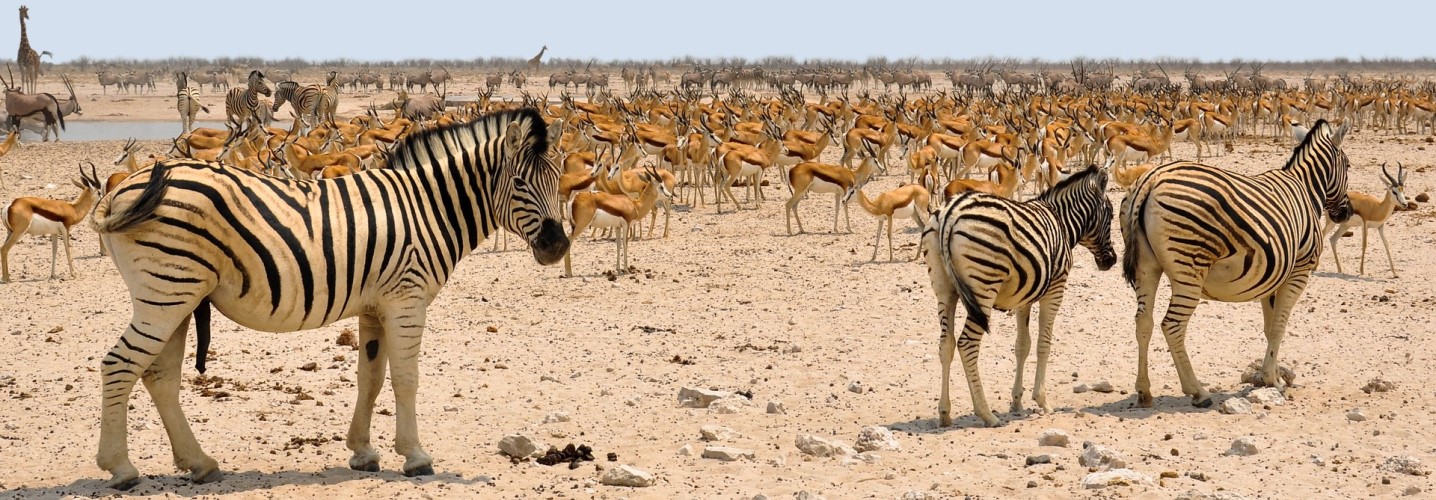





























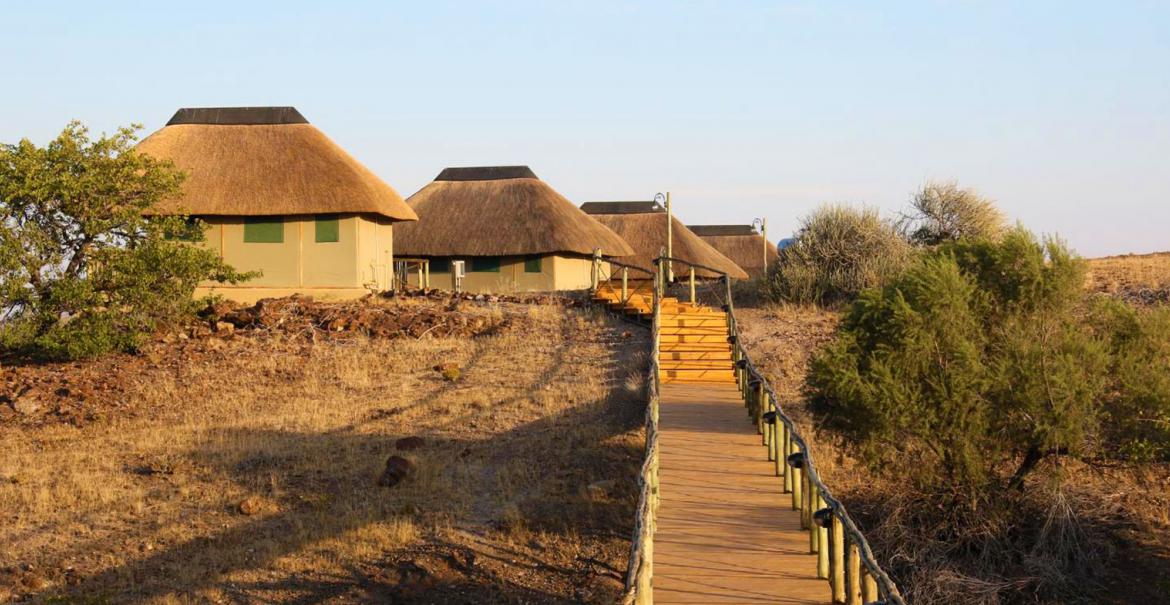






















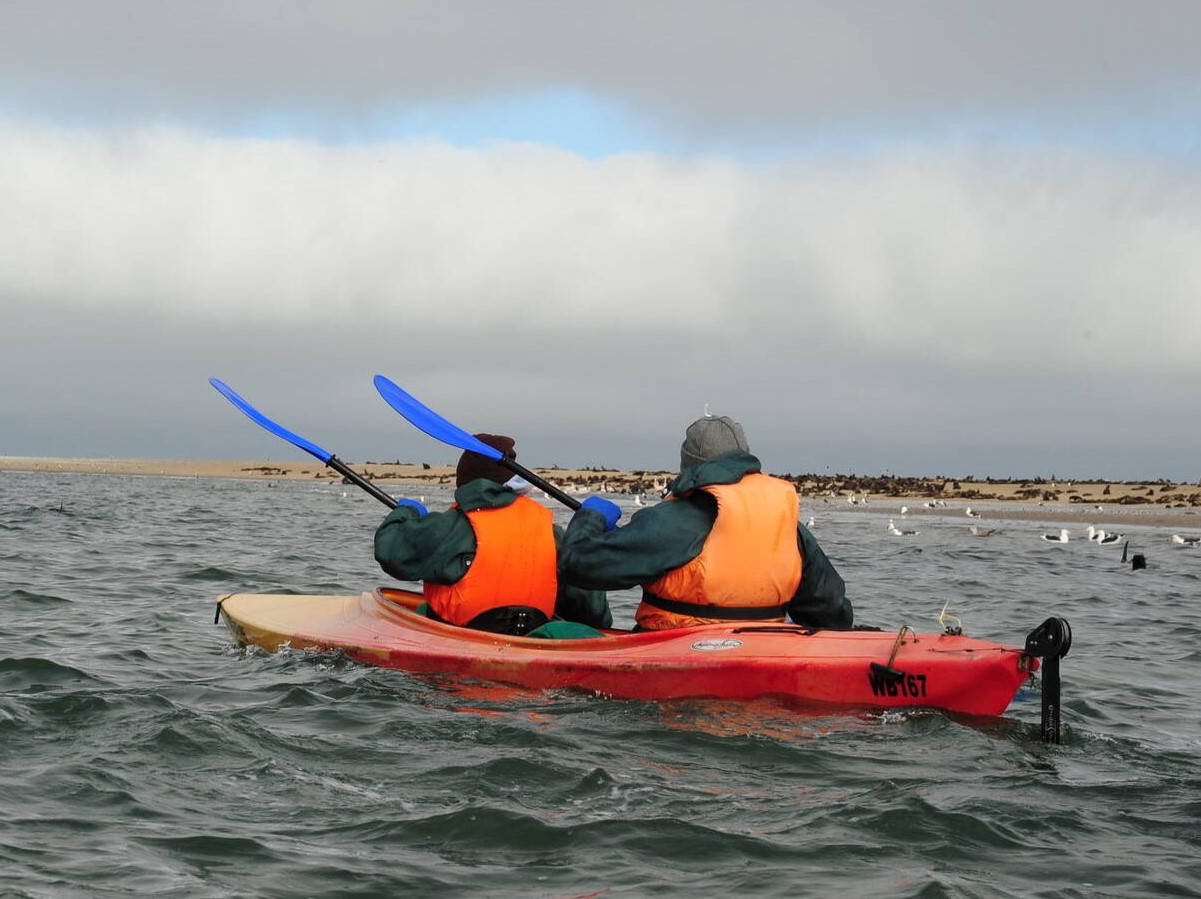
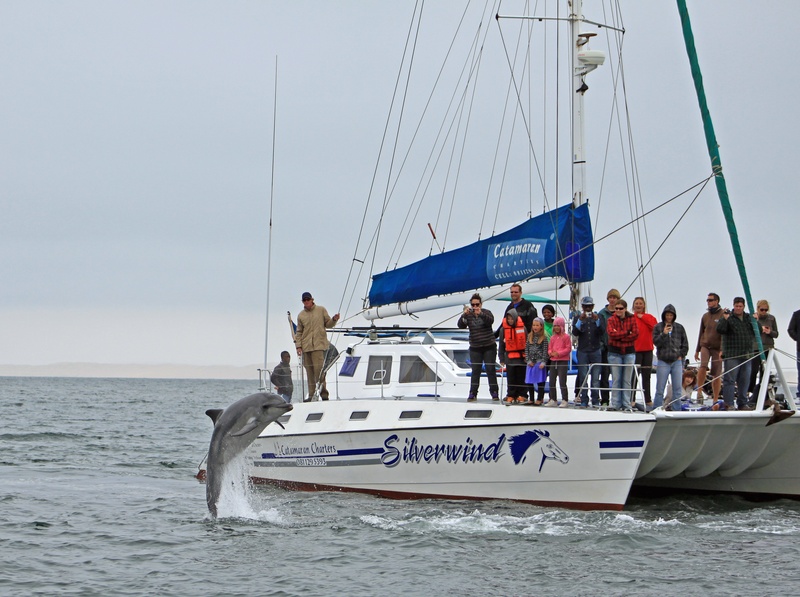

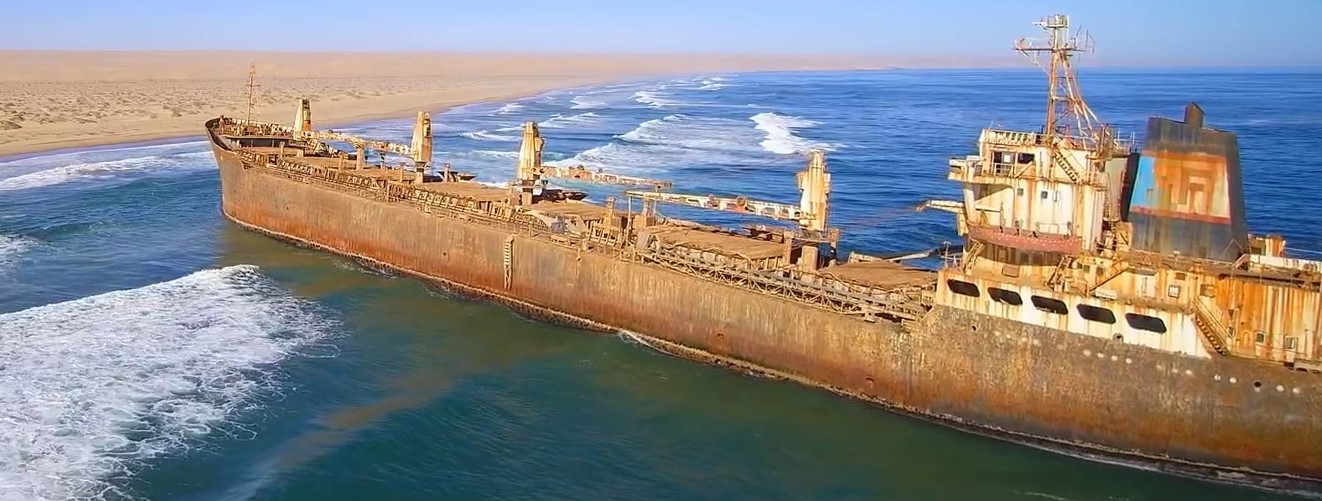










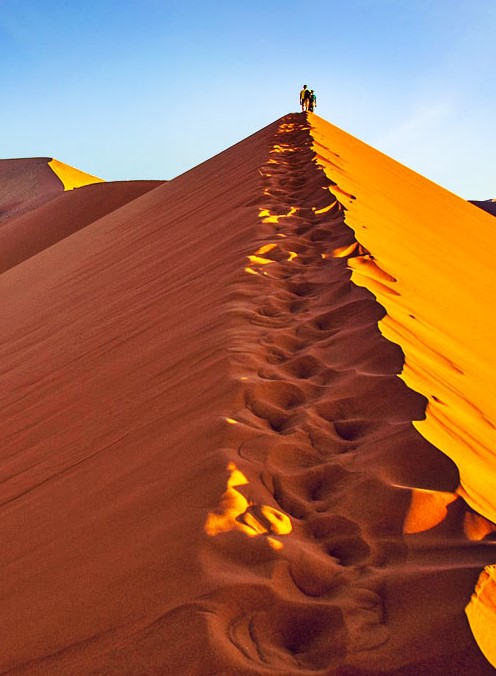


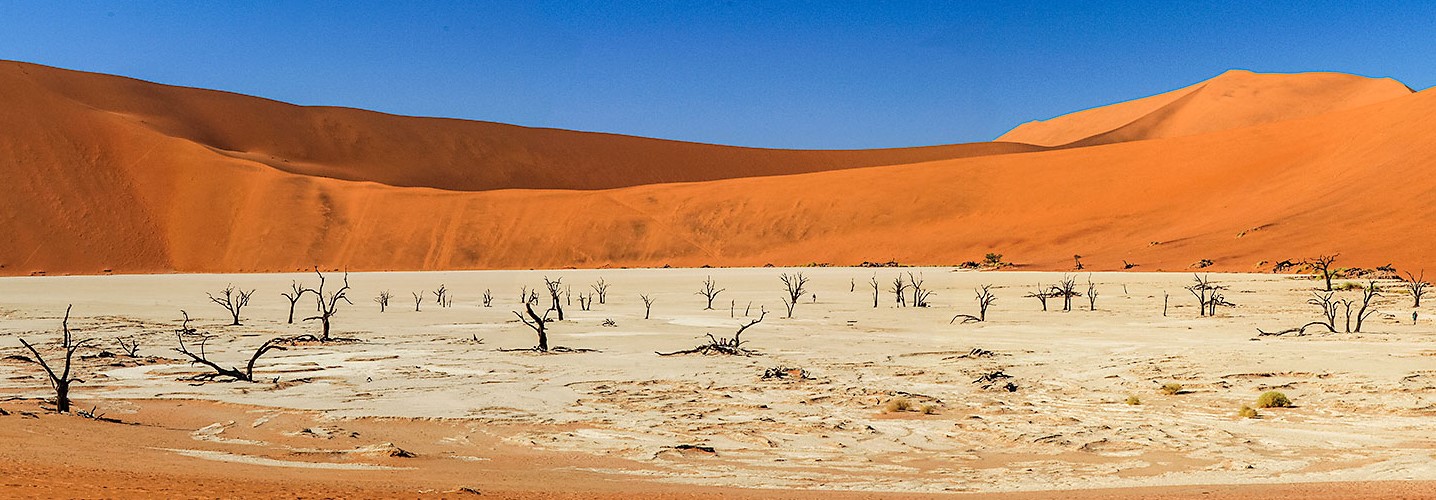










Write a Review